Insights into the Distribution of Soil Organic Carbon in the Maoershan Mountains, Guangxi Province, China: The Role of Environmental Factors
Abstract
:1. Introduction
- (1)
- Are there significant differences in SOC distribution between different forest communities and elevations? Can a unified index be used to evaluate forest soil carbon storage?
- (2)
- Which of the topographic factors, soil factors, or forest factors contributed more to the difference in SOC distribution?
- (3)
- Will the development of plantations into natural forests improve the storage capacity of SOC?
2. Materials and Methods
2.1. Study Sites
2.2. Investigation of Environmental Factors and Soil Sample Collection
2.3. Determination of Soil Samples
2.4. Data Processing
2.4.1. Calculation of Soil Organic Carbon Concentrations (SOCCs) and Soil Organic Carbon Reserves (SOCRs)
2.4.2. Analysis of Variance (ANOVA)
2.4.3. Redundancy Analysis (RDA)
2.4.4. Coefficient of Variation (CV)
3. Results and Analysis
3.1. Spatial Variation in SOC
3.1.1. Horizontal Distribution of SOC
3.1.2. Vertical Distribution of SOC
3.2. RDA of SOC and Environmental Factors
3.2.1. Interpretation of RDA Results
3.2.2. RDA Ranking of SOC and Environmental Factors
3.3. Quantitative Separation and Interpretation Ability of Environmental Factors
4. Discussion
4.1. Response of SOC Distribution to Forest Community
4.2. Response of SOC Distribution to Elevation Gradient
4.3. Response of SOC Distribution to Soil Depth
4.4. Response of SOC Distribution to the Interactions between Environmental Factors
5. Conclusions
Author Contributions
Funding
Institutional Review Board Statement
Informed Consent Statement
Data Availability Statement
Acknowledgments
Conflicts of Interest
References
- Akram, M.A.; Wang, X.; Hu, W.; Xiong, J.; Zhang, Y.; Deng, Y.; Ran, J.; Deng, J. Convergent Variations in the Leaf Traits of Desert Plants. Plants 2020, 9, 990. [Google Scholar] [CrossRef] [PubMed]
- Li, H.; Wu, Y.; Chen, J.; Zhao, F.; Wang, F.; Sun, Y.; Zhang, G.; Qiu, L. Responses of soil organic carbon to climate change in the Qilian Mountains and its future projection. J. Hydrol. 2021, 596, 126110. [Google Scholar] [CrossRef]
- Cardon, Z.G.; Hungate, B.A.; Cambardella, C.A.; Chapin, F.S.; Field, C.B.; Holland, E.A.; Mooney, H.A. Contrasting effects of elevated CO2 on old and new soil carbon pools. Soil Biol. Biochem. 2001, 33, 365–373. [Google Scholar] [CrossRef]
- Osipov, A.F.; Bobkova, K.S.; Dymov, A.A. Carbon stocks of soils under forest in the Komi Republic of Russia. Geoderma Reg. 2021, 27, e00427. [Google Scholar] [CrossRef]
- Angst, G.; Mueller, K.E.; Nierop, K.G.J.; Simpson, M.J. Plant- or microbial-derived? A review on the molecular composition of stabilized soil organic matter. Soil Biol. Biochem. 2021, 156, 108189. [Google Scholar] [CrossRef]
- Wiesmeier, M.; Urbanski, L.; Hobley, E.; Lang, B.; von Lützow, M.; Marin-Spiotta, E.; van Wesemael, B.; Rabot, E.; Ließ, M.; Garcia-Franco, N.; et al. Soil organic carbon storage as a key function of soils–A review of drivers and indicators at various scales. Geoderma 2019, 333, 149–162. [Google Scholar] [CrossRef]
- Li, Q.; Huang, Y.; Liu, G.; Zeng, X. The Contents and Character Of Heavy Metals Of Main Soil Types In Three Gorge Reservoir. Acta Pedol. Sin. 2004, 41, 301–304. [Google Scholar]
- Pan, Y.; Birdsey, R.A.; Fang, J.; Houghton, R.; Kauppi, P.E.; Kurz, W.A.; Phillips, O.L.; Shvidenko, A.; Lewis, S.L.; Canadell, J.G.; et al. A large and persistent carbon sink in the world’s forests. Science 2011, 333, 988–993. [Google Scholar] [CrossRef]
- IPCC Climate Change. The physical science basis. Contrib. Work. Group I Fifth Assess. Rep. Intergov. Panel Clim. Change 2013, 1535, 2013. [Google Scholar]
- Houghton, R.A. Land-use change and the carbon cycle. Glob. Chang. Biol. 1995, 1, 275–287. [Google Scholar] [CrossRef]
- Zhou, G.; Liu, S.; Li, Z.; Zhang, D.; Tang, X.; Zhou, C.; Yan, J.; Mo, J. Old-growth forests can accumulate carbon in soils. Science 2006, 314, 1417. [Google Scholar] [CrossRef] [PubMed]
- Schrumpf, M.; Schulze, E.D.; Kaiser, K.; Schumacher, J. How accurately can soil organic carbon stocks and stock changes be quantified by soil inventories? Biogeosciences 2011, 8, 1193–1212. [Google Scholar] [CrossRef]
- Ter Braak, C.J.; Smilauer, P. CANOCO Reference Manual and CanoDraw for Windows User’s Guide: Software for Canonical Community Ordination, version 4.5; 2002. Available online: https://www.scienceopen.com/document?vid=f1f55dd4-0d25-4b5f-ba80-1b47296bc070 (accessed on 18 April 2023).
- Smith, P.; House, J.I.; Bustamante, M.; Sobocka, J.; Harper, R.; Pan, G.; West, P.C.; Clark, J.M.; Adhya, T.; Rumpel, C.; et al. Global change pressures on soils from land use and management. Glob. Change Biol. 2016, 22, 1008–1028. [Google Scholar] [CrossRef] [PubMed]
- Hou, G.; Delang, C.O.; Lu, X.; Gao, L. A meta-analysis of changes in soil organic carbon stocks after afforestation with deciduous broadleaved, sempervirent broadleaved, and conifer tree species. Ann. For. Sci. 2020, 77, 92. [Google Scholar] [CrossRef]
- Pita, G.; Gielen, B.; Zona, D.; Rodrigues, A.; Rambal, S.; Janssens, I.A.; Ceulemans, R. Carbon and water vapor fluxes over four forests in two contrasting climatic zones. Agric. For. Meteorol. 2013, 180, 211–224. [Google Scholar] [CrossRef]
- Wu, X.; Wang, W.; Li, B.; Liang, Y.; Liu, Y. Altitudinal Gradient of Soil Organic Carbon in Forest Soils in the Mid-Subtropical Zone of China. Acta Pedol. Sin. 2020, 57, 1539–1547. [Google Scholar]
- Li, G.; Shi, L.; Zhang, Z.; Grace, J.; Yang, M.; Wu, S.; Lei, G. Distribution of soil organic carbon and potential carbon sequestration in an alpine meadow grazed by domesticated yak in Zeku, Qinghai-Tibetan Plateau, China. Carbon Manag. 2019, 10, 135–147. [Google Scholar] [CrossRef]
- Khosravi Aqdam, K.; Yaghmaeian Mahabadi, N.; Ramezanpour, H.; Rezapour, S.; Mosleh, Z.; Zare, E. Comparison of the uncertainty of soil organic carbon stocks in different land uses. J. Arid Environ. 2022, 205, 104805. [Google Scholar] [CrossRef]
- Breg Valjavec, M.; Čarni, A.; Žlindra, D.; Zorn, M.; Marinšek, A. Soil organic carbon stock capacity in karst dolines under different land uses. Catena 2022, 218, 106548. [Google Scholar] [CrossRef]
- Grandy, A.S.; Robertson, G.P. Land-Use Intensity Effects on Soil Organic Carbon Accumulation Rates and Mechanisms. Ecosystems 2007, 10, 59–74. [Google Scholar] [CrossRef]
- Ahirwal, J.; Gogoi, A.; Sahoo, U.K. Stability of soil organic carbon pools affected by land use and land cover changes in forests of eastern Himalayan region, India. Catena 2022, 21, 106308. [Google Scholar] [CrossRef]
- Jobbagy, E.G.; Jackson, R.B. The Vertical Distribution of Soil Organic Carbon and Its Relation to Climate and Vegetation. Ecol. Appl. 2000, 10, 423–436. [Google Scholar] [CrossRef]
- Du, X.; Wang, H. Active Components of Forest Soil Organic Carbon and Its Influencing Factors in China. World For. Res. 2022, 35, 76–81. [Google Scholar] [CrossRef]
- Woodwell, G.M.; Whittaker, R.H.; Reiners, W.A.; Likens, G.E.; Delwiche, C.C.; Botkin, D.B. The biota and the world carbon budget. Science 1978, 199, 141–146. [Google Scholar] [CrossRef]
- Dixon, R.K.; Solomon, A.M.; Brown, S.; Houghton, R.A.; Trexier, M.C.; Wisniewski, J. Carbon pools and flux of global forest ecosystems. Science 1994, 263, 185–190. [Google Scholar] [CrossRef] [PubMed]
- Bradshaw, C.J.A.; Warkentin, I.G. Global estimates of boreal forest carbon stocks and flux. Glob. Planet. Change 2015, 128, 24–30. [Google Scholar] [CrossRef]
- Wei, H.; Ma, X.; Liu, A.; Feng, L.; Huang, Y. Review on carbon cycle of forest ecosystem. Chin. J. Eco-Agric. 2007, 15, 188–192. [Google Scholar]
- Liu, S.; Wang, H.; Luan, J. A review of research progress and future prospective of forest soil carbon stock and soil carbon process in China. Acta Ecol. Sin. 2011, 31, 5437–5448. [Google Scholar]
- Zhang, Y.-R.; Ouyang, X.; Chu, G.-W.; Zhang, Q.-M.; Liu, S.-Z.; Zhang, D.-Q.; Li, Y.-L. Spatial heterogeneity of soil organic carbon and total nitrogen in a monsoon evergreen broadleaf forest in Dinghushan, Guangdong, China. Chin. J. Appl. Ecol. 2014, 25, 19–23. [Google Scholar] [CrossRef]
- Wang, J.; Li, H.; Duan, W.; Tang, D.; Wang, S.; Liu, X.; Huang, H. Runoff Processes and the Influencing Factors in a Small Forested Watershed of Upper Reaches of Lijiang River. Sci. Silvae Sin. 2013, 49, 149–153. [Google Scholar]
- Huang, Y.; Chen, G.; Liu, B.; Lin, S.; Yang, X. Formation Characteristics and Taxonomy of Soils in Maoer Mountains in Guangxi. Chin. Agric. Sci. Bull. 2010, 26, 188–193. [Google Scholar]
- Huang, J.; Jiang, D. Comprehensive and Scientific Investigation in Guangxi Maoershan Nature Reserve; Hunan Science and Technology Press: Changsha, China, 2002. [Google Scholar]
- Wang, H.; Yan, W.; Wang, J.; Duan, W. Exploring Distribution Rules and Variation Trends of Precipitation in the Upper Lijiang River from 1951 to 2016, Guangxi Province, China. J. Coast. Res. 2020, 105, 1–5. [Google Scholar] [CrossRef]
- Duan, W.; Wang, J. Vertical distribution pattern and determinant analysis of forest community in Maoer Mountain National Nature Reserve. Ecol. Environ. Sci. 2013, 22, 563–566. [Google Scholar] [CrossRef]
- Webster, R. Quantitative Spatial Analysis of Soil in the Field. In Soil Restoration, Advances in Soil Science; Springer: New York, NY, USA, 1985; Volume 3, pp. 1–70. [Google Scholar]
- Trangmar, B.B.; Yost, R.S.; Uehara, G. Application of Geostatistics to Spatial Studies of Soil Properties. Adv. Agron. 1986, 38, 45–94. [Google Scholar] [CrossRef]
- GB/T 33027-2016; Institute of Forest Ecology, Environment and Protection, Chinese Academy of Forestry, Method for Long-Term Positioning and Observation of Forest Ecosystems. In General Administration of Quality Supervision, Inspection and Quarantine of the People’s Republic of China; Standardization Administration of China: Beijing, China, 2016; p. 112.
- Haluschak, P. Laboratory methods of soil analysis. Can.-Manit. Soil Surv. 2006, 3–133. [Google Scholar]
- Nelson, D.W.; Sommers, L.E. Total carbon, organic carbon, and organic matter. Methods Soil Anal. Part 3 Chem. Methods 1996, 5, 961–1010. [Google Scholar]
- Cao, X.G.; Yue, W.P.; Deng, J. Soil organic carbon distribution characteristics along an altitudinal gradient in the north-ern subtropical region:a case study in Guifeng Mountains of Eastern Hubei, China. J. Guangxi Norm. Univ. 2021, 39, 174–182. [Google Scholar] [CrossRef]
- Huang, B.; Wang, Q.-Q.; Li, D.-Q.; Xiao, H.-B.; Nie, X.-D.; Yuan, Z.-J.; Zheng, M.-G.; Liao, Y.S.; Liang, C. Variation Characteristics of Organic Carbon and Fractions in Soils along the Altitude Gra-dient in Nanling Mountains. Chin. J. Soil Sci. 2022, 53, 374–383. [Google Scholar] [CrossRef]
- Shen, K.-H.; Wei, S.-G.; Li, L.; Chu, X.-X.; Zhong, J.-J.; Zhou, J.-G.; Zhao, Y. Spatial Distribution Patterns of Soil Organic Carbon in Karst Forests of the Lijiang River Basin and Its Driving Factors. Environ. Sci. 2022, 216, 106409. [Google Scholar] [CrossRef]
- Zhang, Z.; Huang, X.; Zhou, Y. Spatial heterogeneity of soil organic carbon in a karst region under different land use patterns. Ecosphere 2020, 11, e03077. [Google Scholar] [CrossRef]
- Deng, X.; Zhu, L.; Song, X.-c.; Tang, J.; Tan, Y.-b.; Deng, N.-n.; Zheng, W.; Cao, J. Soil Ecological Stoichiometry Characteristics of Different Stand Types in Maoershan Nature Reserve. Chin. J. Soil Sci. 2022, 53, 366–373. [Google Scholar] [CrossRef]
- Raich, J.W.; Schlesinger, W.H. The global carbon dioxide flux in soil respiration and its relationship to vegetation and climate. Tellus B 1992, 44, 81–99. [Google Scholar] [CrossRef]
- Vesterdal, L.; Clarke, N.; Sigurdsson, B.D.; Gundersen, P. Do tree species influence soil carbon stocks in temperate and boreal forests? For. Ecol. Manag. 2013, 309, 4–18. [Google Scholar] [CrossRef]
- Don, A.; Schumacher, J.; Freibauer, A. Impact of tropical land-use change on soil organic carbon stocks—A meta-analysis. Glob. Change Biol. 2011, 17, 1658–1670. [Google Scholar] [CrossRef]
- Hong, X.; Li, M.; Yu, T.-w.; Yan, Q.; Wei, Q.; Hu, Y.-l. Effects of aboveground and belowground litter inputs on the balance of soil new and old organic carbon under the typical forests in subtropical region. Chin. J. Appl. Ecol. 2021, 32, 825–835. [Google Scholar] [CrossRef]
- Yu, X.; Xu, C.; Zhu, Y.; Xu, X. Litterfall production and its relation to stand structural factors in a subtropical evergreen broadleaf forest. J. Zhejiang AF Univ. 2016, 33, 991–999. [Google Scholar]
- Gong, L.; Liu, G.; Li, Z.; Ye, X.; Wang, H. Altitudinal changes in nitrogen, organic carbon, and its labile fractions in different soil layers in an Abies faxoniana forest in Wolong. Acta Ecol. Sin. 2017, 37, 4696–4705. [Google Scholar]
- Qin, H.; Fu, X.; Lu, Y.; Wei, X.; Li, B.; Jia, C. Soil C: N: P stoichiometry at different altitudes in Mao’er Mountain, Guangxi, China. Chin. J. Appl. Ecol. 2019, 30, 711–717. [Google Scholar] [CrossRef]
- Liu, K.; Li, M.; Li, L.; Tian, K.; Wang, Z.; Qu, M.; Fan, Y.N.; Huang, B. Spatial heterogeneity of the soil organic carbon density and its driving factors in the water source area of the Middle Route of China South-to-North Water Diversion Project. J. Nanjing For. Univ. 2022, 46, 35–43. [Google Scholar]
- Zhao, Q.; Liu, S.; Chen, K.; Wang, S.; Wu, C.; Li, J.; Lin, Y. Change characteristics and influencing factors of soil organic carbon in Castanopsis eyrei natural forests at different altitudes in Wuyishan Nature Reserve. Acta Ecol. Sin. 2021, 41, 5328–5339. [Google Scholar]
- Pang, S.; Zhang, P.; Yang, B.; Jia, H.; Huang, B.; Liu, S. The distribution of organic carbon and soil nutrients under four forest types in karst mountain areas of northwest Guangxi, China. J. Cent. South Univ. For. Technol. 2018, 38, 60–64+71. [Google Scholar] [CrossRef]
- Liu, M.; Sun, J.; Xu, X. Imbalance of soil elements drives the degradation of alpine grasslands. Chin. J. Ecol. 2020, 39, 2574–2580. [Google Scholar] [CrossRef]
- Fang, J.; Yu, G.; Liu, L.; Hu, S.; Chapin, F.S., 3rd. Climate change, human impacts, and carbon sequestration in China. Proc. Natl. Acad. Sci. USA 2018, 115, 4015–4020. [Google Scholar] [CrossRef] [PubMed]
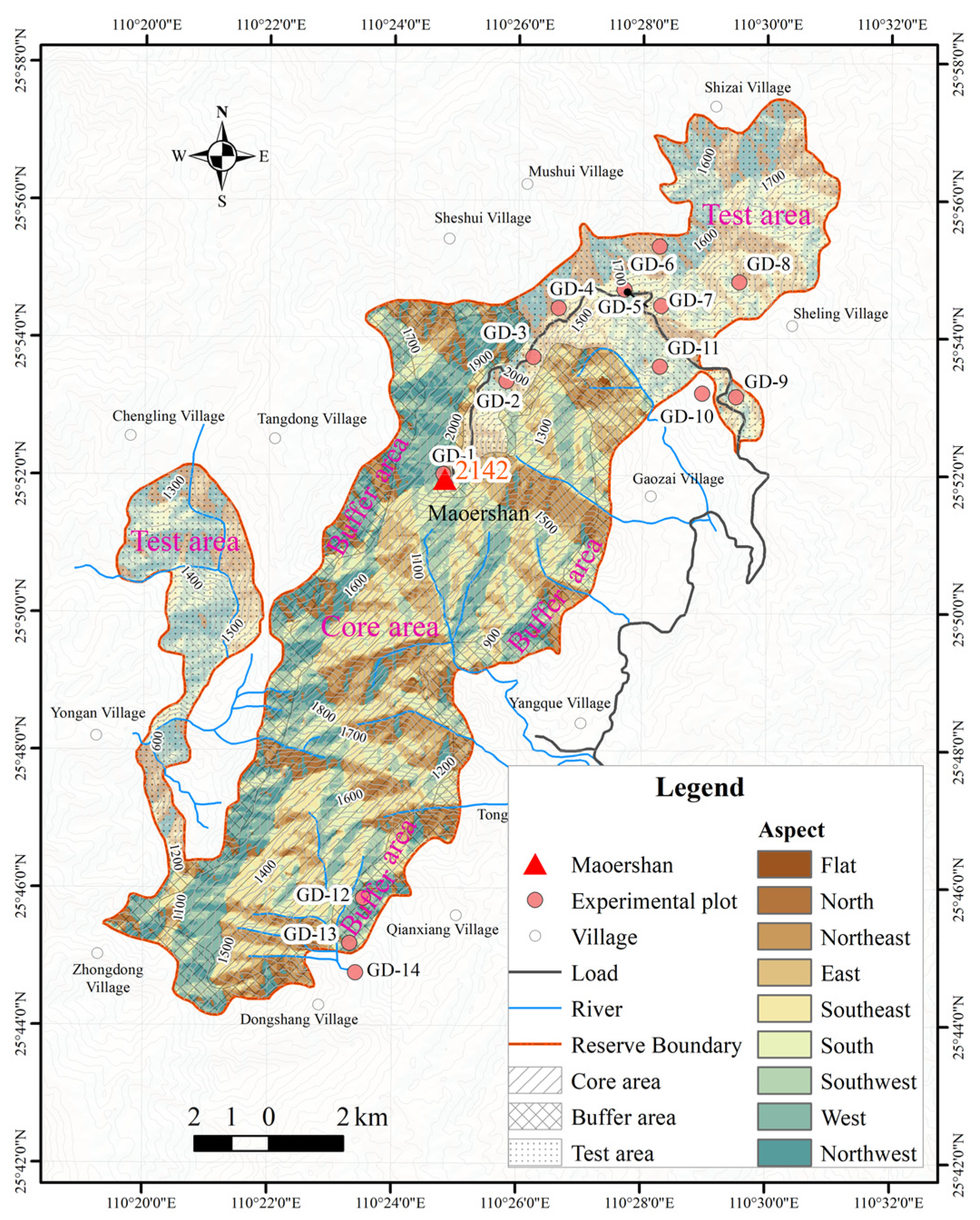

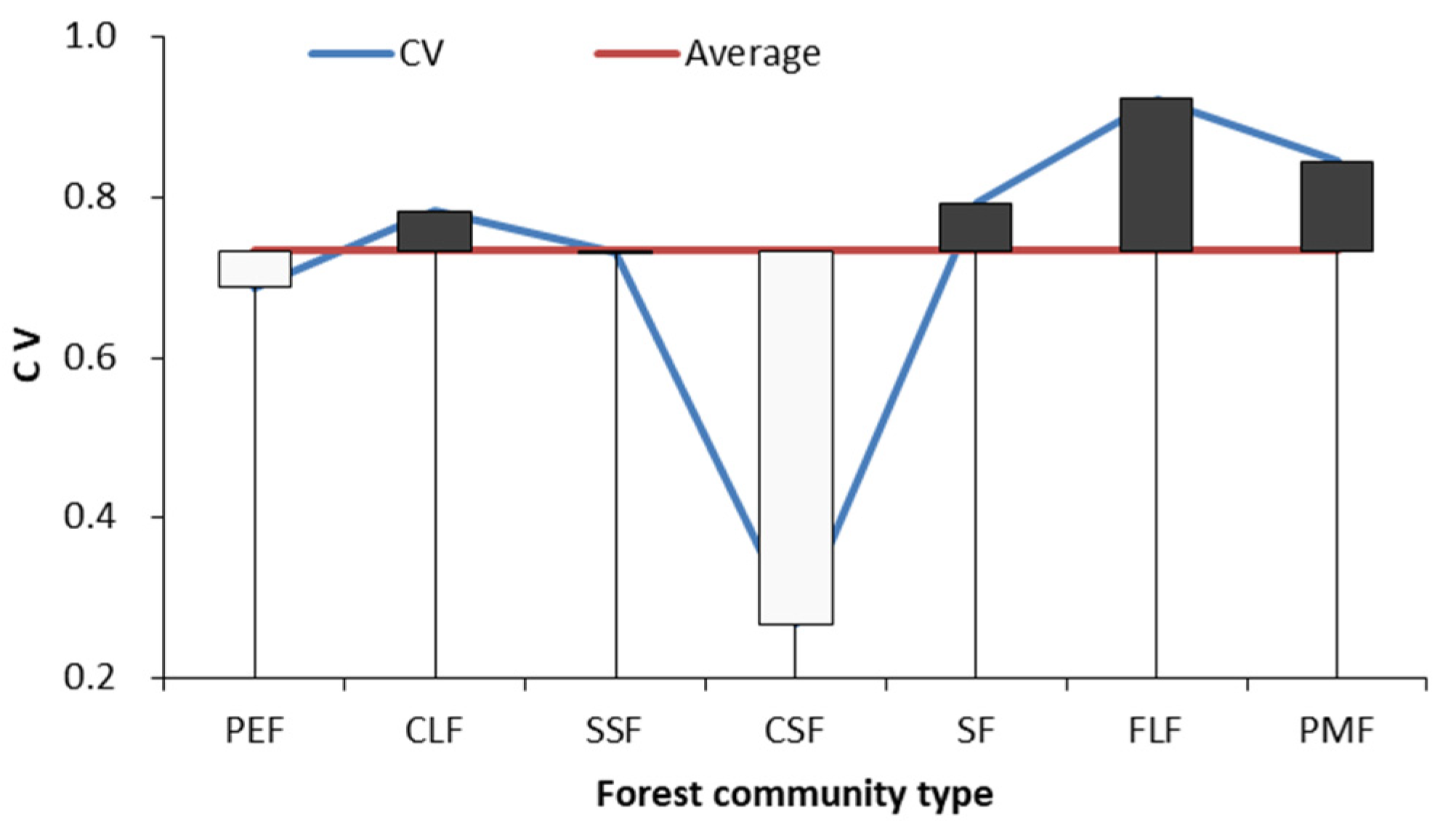
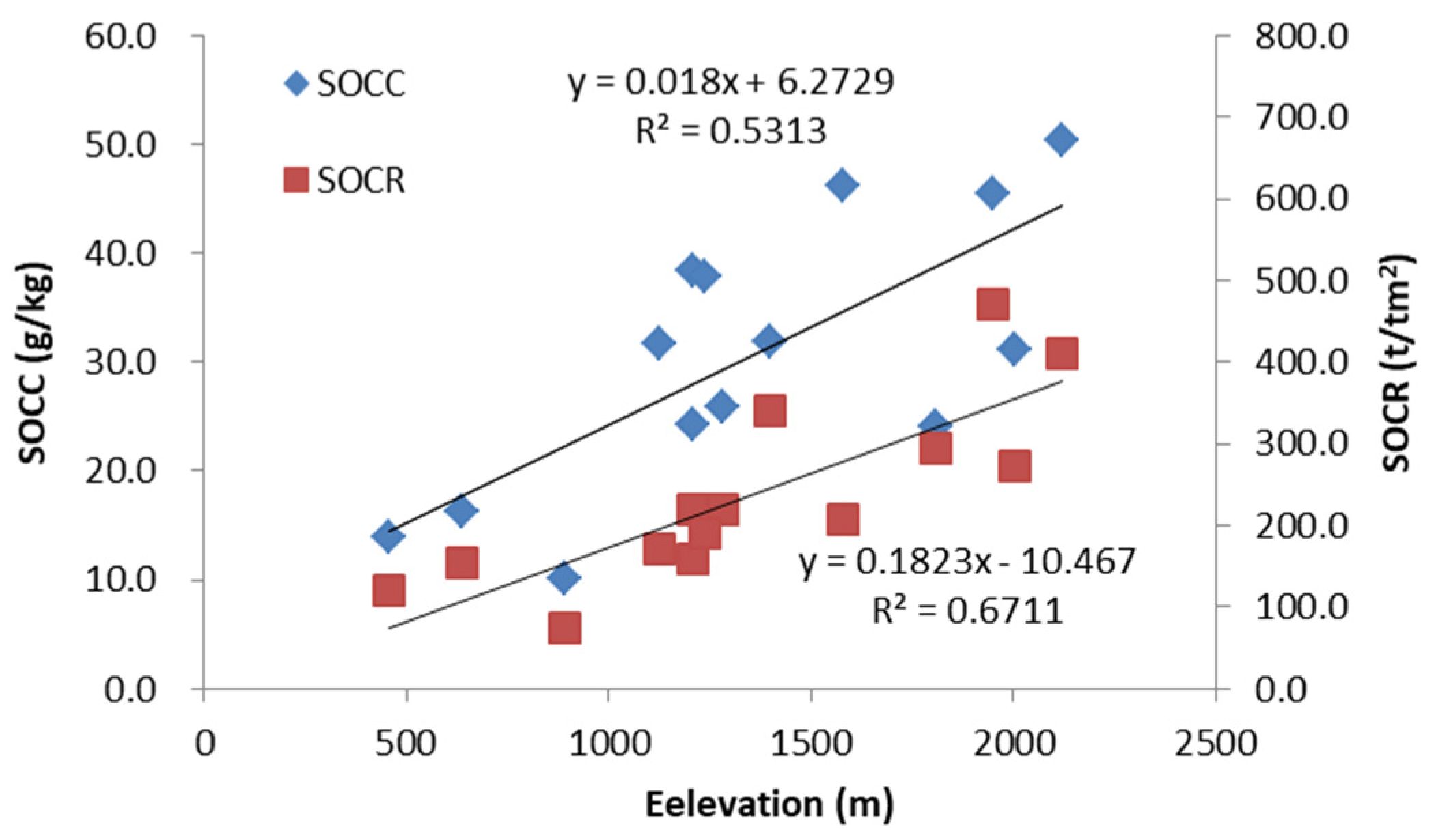
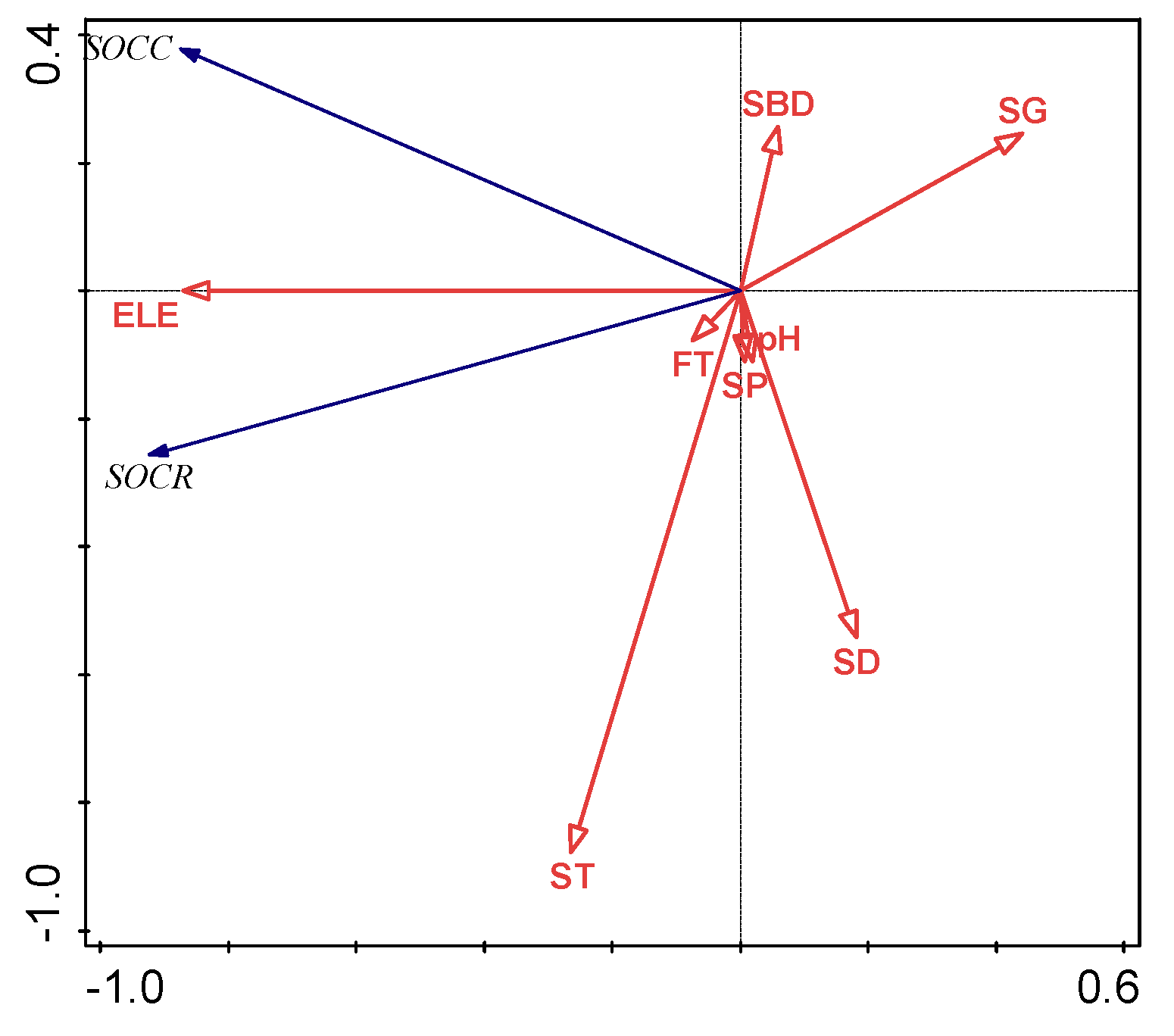
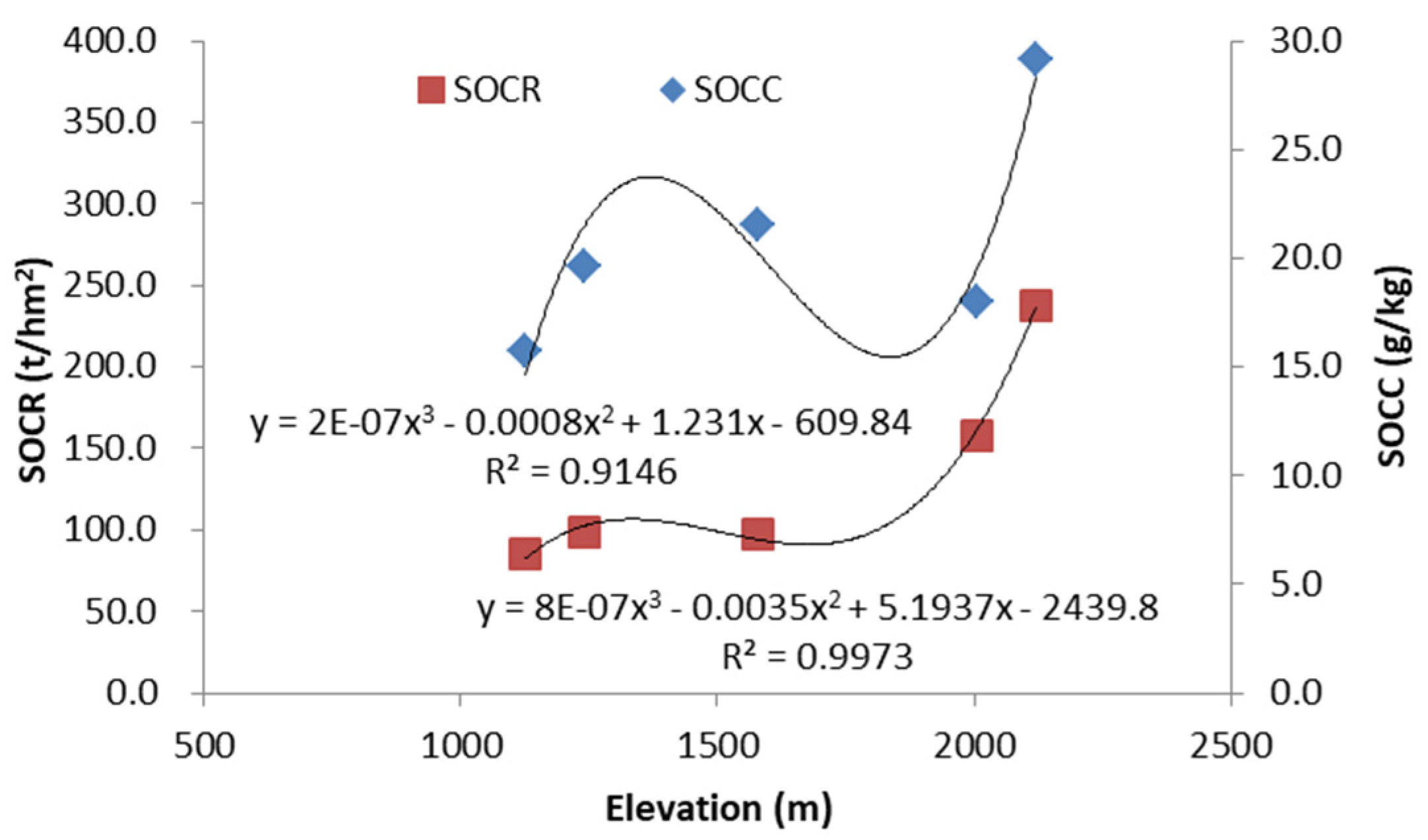
| Elevation | Forest Vegetation Types | Soil Types [32,33] |
|---|---|---|
| <400 m | 1. Phyllostachys Edulis forests (plantations) 2. Cunninghamia lanceolate forests (plantations) 3. Shrub forests (secondary forest) | Hilly red soil |
| 400–700 m | 1. Deciduous broad-leaved forest (secondary forest) 2. Phyllostachys Edulis forests (plantations) 3. Cunninghamia lanceolate forests (plantations) 4. Shrub forests (secondary forest) | Mountain yellow–red soil |
| 700–1200 m | 1. Evergreen broad-leaved forest (secondary forest) 2. Deciduous broad-leaved forest (secondary forest) 3. Phyllostachys Edulis forests (plantations) 4. Shrub forests (secondary forest) | Mountain yellow soil |
| 1200–1800 m | 1. Evergreen deciduous broad-leaved mixed forest (secondary forest) 2. Evergreen broad-leaved forest (secondary forest) 3. Shrub forests (secondary forest) 4. Bamboo forests (secondary forest) | Mountain brown soil Mountain yellow–brown soil |
| 1800–2000 m | 1. Mountain top coppice (secondary forest) 2. Shrub forests (secondary forest) | Peat soil |
| >2000 m | Mountain meadow | Hilltop dwarf forest soil |
| Forest Community | Elevation(m) | Slope Position | Slope Gradient (°) | Soil Depth (cm) | Soil pH | Soil Bulk Density (SBD, g/kg) | Stand Density (Plant/hm2)/Canopy Coverage (%) | Name of Dominant Tree Species |
|---|---|---|---|---|---|---|---|---|
| SF | 2120 | Upper | 47 | 85 | 4.2 | 0.960 | 70 | Fargesia spathacea franch; Buxus sinica (Rehd. et Wils.) Cheng |
| SF | 2005 | Middle | 52 | 85 | 4.5 | 1.030 | 75 | Fargesia spathacea franch; Buxus sinica (Rehd. et Wils.) Cheng |
| CSF | 1950 | Lower | 20 | 150 | 4.6 | 0.690 | 1125 | Cyclobalanopsis stewardiana (A. Camus) Y. C. Hsu et H. W. Jen; Prunus spinulosa, Camellia pitardii |
| FLF | 1810 | Upper | 48 | 133 | 4.4 | 0.920 | 1100 | Fagus longipetiolata Seem; Fargesia spathacea franch |
| SF | 1580 | Upper | 55 | 50 | 4.2 | 0.900 | 60 | Fargesia spathacea franch; Buxus sinica (Rehd. et Wils.) Cheng |
| FLF | 1400 | Upper | 52 | 120 | 4.5 | 0.890 | 1100 | Fagus longipetiolata Seem |
| SSF | 1280 | Upper | 57 | 85 | 4.7 | 0.990 | 1600 | Schima superba Gardn. et Champ; Manglietia fordiana Oliv |
| SF | 1240 | Upper | 54 | 55 | 4.4 | 0.910 | 72 | Fargesia spathacea franch |
| PEF | 1210 | Lower | 47 | 60 | 5.0 | 0.954 | 4300 | Phyllostachys pubescens |
| CLF | 1210 | Middle | 48 | 60 | 4.9 | 1.093 | 2850 | Cunninghamia lanceolata |
| SF | 1127 | Upper | 48 | 60 | 4.1 | 0.900 | 75 | Fargesia spathacea franch |
| PMF | 890 | Middle | 50 | 80 | 4.5 | 0.930 | 1232 | Pinus massoniana |
| CLF | 640 | Middle | 47 | 115 | 4.4 | 0.820 | 3050 | Cunninghamia lanceolata |
| PEF | 460 | Middle | 50 | 110 | 4.4 | 0.780 | 4122 | Phyllostachys pubescens |
| Forest Communities | Statistical Parameters | Soil Layers | |||
|---|---|---|---|---|---|
| 0–15 cm | 15–30 cm | 30–45 cm | 45–60 cm | ||
| PEF | Mean (g/kg) | 39.37 (2.67) a | 24.16 (3.53) b | 12.17 (1.48) c | 13.45 (3.67) c |
| SD | 8.61 | 4.51 | 0.39 | 0.71 | |
| CV | 0.219 | 0.187 | 0.032 | 0.052 | |
| CLF | Mean (g/kg) | 28.93 (4.31) a | 11.004 (2.25) b | 7.47 (0.20) b | 7.01 (0.35) b |
| SD | 8.61 | 4.51 | 0.39 | 0.71 | |
| CV | 0.30 | 0.41 | 0.05 | 0.10 | |
| SSF | Mean (g/kg) | 31.25 (3.91) a | 12.86 (3.20) b | 9.23 (3.24) b | 6.90 (1.48) b |
| SD | 6.77 | 5.55 | 5.61 | 2.57 | |
| CV | 0.22 | 0.43 | 0.61 | 0.37 | |
| CSF | Mean (g/kg) | 25.35 (5.81) a | 25.15 (4.81) a | 26.74 (1.56) a | 28.469 (3.33) a |
| SD | 10.06 | 8.34 | 2.70 | 9.23 | |
| CV | 0.40 | 0.33 | 0.10 | 0.32 | |
| SF | Mean (g/kg) | 44.42 (6.72) a | 19.67 (2.33) b | 10.80 (1.88) bc | 8.40 (1.33) c |
| SD | 15.03 | 5.20 | 4.21 | 2.98 | |
| CV | 0.34 | 0.27 | 0.39 | 0.36 | |
| FLF | Mean (g/kg) | 36.39 (5.72) a | 20.36 (1.72) b | 5.88 (1.65) c | 4.89 (2.65) c |
| SD | 8.08 | 2.44 | 2.34 | 3.74 | |
| CV | 0.22 | 0.12 | 0.40 | 0.77 | |
| PMF | Mean (g/kg) | 12.45 | 6.51 | 3.20 | 1.17 |
| Total | Mean (g/kg) | 32.90 (2.72) a | 17.51 (1.63) b | 11.32 (1.55) c | 10.60 (1.86) c |
| SD | 12.74 | 7.62 | 7.28 | 8.71 | |
| CV | 0.38 | 0.44 | 0.64 | 0.82 | |
| Axis | 1 | 2 | 3 | 4 |
|---|---|---|---|---|
| Eigenvalues | 0.82 | 0.10 | 0.09 | 0.00 |
| Explained variation (cumulative) | 81.56 | 91.37 | 99.94 | 100 |
| Pseudo-canonical correlation | 0.95 | 1.00 | 0 | 0 |
| Explained fitted variation (cumulative) | 89.27 | 100 |
| Model | Eigenvalue | Condition Index | Variance Ratio | ||||||||
|---|---|---|---|---|---|---|---|---|---|---|---|
| Constant | FT | ELE | SP | SG | ST | pH | SBD | SD | |||
| 1 | 8.44 | 1.00 | 0.00 | 0.00 | 0.00 | 0.00 | 0.00 | 0.00 | 0.00 | 0.00 | 0.00 |
| 2 | 0.29 | 5.44 | 0.00 | 0.08 | 0.01 | 0.06 | 0.00 | 0.00 | 0.00 | 0.00 | 0.00 |
| 3 | 0.13 | 7.95 | 0.00 | 0.02 | 0.02 | 0.01 | 0.01 | 0.04 | 0.00 | 0.00 | 0.00 |
| 4 | 0.08 | 10.07 | 0.00 | 0.00 | 0.11 | 0.06 | 0.00 | 0.08 | 0.00 | 0.00 | 0.00 |
| 5 | 0.05 | 12.43 | 0.00 | 0.41 | 0.11 | 0.17 | 0.00 | 0.02 | 0.00 | 0.00 | 0.00 |
| 6 | 0.00 | 44.78 | 0.01 | 0.03 | 0.04 | 0.47 | 0.65 | 0.14 | 0.01 | 0.02 | 0.06 |
| 7 | 0.00 | 58.34 | 0.28 | 0.03 | 0.02 | 0.04 | 0.00 | 0.11 | 0.01 | 0.35 | 0.00 |
| 8 | 0.00 | 101.32 | 0.48 | 0.36 | 0.52 | 0.00 | 0.32 | 0.41 | 0.03 | 0.62 | 0.46 |
| 9 | 0.00 | 129.55 | 0.23 | 0.07 | 0.16 | 0.18 | 0.02 | 0.20 | 0.95 | 0.00 | 0.47 |
| Environmental Factor | Explanation Rate (%) | Contribution Rate (%) | Pseudo-F | p |
|---|---|---|---|---|
| ELE | 61.90 | 67.80 | 19.50 | 0.00 |
| FT | 11.10 | 12.20 | 4.50 | 0.04 |
| ST | 9.30 | 10.20 | 5.30 | 0.02 |
| SBD | 4.60 | 5.00 | 3.20 | 0.09 |
| SP | 2.40 | 2.60 | 1.80 | 0.19 |
| SD | 1.60 | 1.80 | 1.30 | 0.28 |
| pH | 0.30 | 0.30 | 0.20 | 0.68 |
| SG | <0.10 | <0.10 | <0.10 | 0.85 |
| Environmental Factors | Pseudo-F | p |
|---|---|---|
| Forests | 0.50 | 0.66 |
| Topographic | 6.50 | 0.00 |
| Soil | 0.70 | 0.06 |
| All environmental factors | 6.60 | 0.01 |
Disclaimer/Publisher’s Note: The statements, opinions and data contained in all publications are solely those of the individual author(s) and contributor(s) and not of MDPI and/or the editor(s). MDPI and/or the editor(s) disclaim responsibility for any injury to people or property resulting from any ideas, methods, instructions or products referred to in the content. |
© 2023 by the authors. Licensee MDPI, Basel, Switzerland. This article is an open access article distributed under the terms and conditions of the Creative Commons Attribution (CC BY) license (https://creativecommons.org/licenses/by/4.0/).
Share and Cite
Wang, H.; Wang, J.; Wang, J.; Yan, W. Insights into the Distribution of Soil Organic Carbon in the Maoershan Mountains, Guangxi Province, China: The Role of Environmental Factors. Sustainability 2023, 15, 8716. https://doi.org/10.3390/su15118716
Wang H, Wang J, Wang J, Yan W. Insights into the Distribution of Soil Organic Carbon in the Maoershan Mountains, Guangxi Province, China: The Role of Environmental Factors. Sustainability. 2023; 15(11):8716. https://doi.org/10.3390/su15118716
Chicago/Turabian StyleWang, Hailun, Jiachen Wang, Jinye Wang, and Wende Yan. 2023. "Insights into the Distribution of Soil Organic Carbon in the Maoershan Mountains, Guangxi Province, China: The Role of Environmental Factors" Sustainability 15, no. 11: 8716. https://doi.org/10.3390/su15118716





